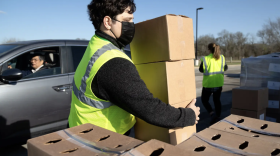Texas agriculture experts are warning commercial poultry producers and residents with backyard flocks to be on guard now that a virulent strain of avian influenza has reached Texas. The virus has already devastated domesticated bird populations in other parts of North America.
Earlier this month, the Texas Animal Health Commission (TAHC) and U.S. Department of Agriculture Animal and Plant Health Inspection Service (APHIS) confirmed Texas’ first case of the H5N1 strain of a virus, which originated in Europe in fall 2020.
"Luckily, it was not in our commercial broiler or commercial egg-laying facilities here across the state. It was a much smaller operation that produces pheasants and game birds," said Tracy Tomascik, Texas Farm Bureau Commodity and Regulatory Activities associate director, in an interview with The Texas Newsroom.
Texas’ first positive tests showed up April 2 in pheasants raised for hunting at a game-bird ranch in Erath County, about 70 miles southwest of Fort Worth. The outbreak forced the operator to euthanize its entire mixed-bird flock of pheasants, quail and ducks due to exposure.
According to the U.S. Center for Disease Control and Prevention, “the risk to the general public’s health from current H5N1 bird flu viruses is low, however some people may have job-related or recreational exposures to birds that put them at higher risk of infection.”
The highly pathogenic variant has been confirmed among wild bird populations in more than 30 states and Canada. Outbreaks so far have forced commercial poultry operations, primarily in the Midwest, to euthanize roughly 22 million mostly egg-laying chickens.
The commercial losses to egg and poultry markets have contributed to rising prices in the U.S., but Texas has been less impacted than other regions.
"Our consumers aren't being hit very hard and we hope it stays that way. Our farmers are doing their very best to prevent something like that from occurring," Tomascik said, explaining the state’s commercial poultry producers, located primarily in East Texas, have enhanced bio security measures since the U.S.’s last major outbreak of bird flu in 2015.
According to Texas A&M AgriLife Extension Service associate professor and poultry specialist Gregory Archer, the virus is believed to have spread across the globe through migratory birds that are less vulnerable to getting sick and dying.
“They come over through Russia and China, across into Alaska and then into Canada. And then they migrate down south through the flyaways,” Archer told The Texas Newsroom. “That’s basically where we’ve seen [the outbreaks] start: in the flyaways on the east coast and it’s made its way west as the birds start to migrate more in that direction.”
What to do if you have backyard chickens
The chances for bird-born viruses to spread has grown over the past decade with what Archer called the “exponential increase” in keeping backyard chickens, a trend that accelerated during the pandemic.
For that reason, he urged Texans tending their own flocks to take extra precautions during the current bird migration season.
“Don't encourage wild birds to come on to your property where your chickens are by putting bird feeders out and things like that," Archer said. If you have a pond on your property or farm, "don't let your birds go down … to interact with wild ducks.”
Archer said humans can also expose their at-home flocks to the virus by tracking it in from elsewhere.
“Especially this time of year when we’ve got migratory birds [traveling across the state], try to limit your exposure to those birds,” he said. “Limit exposure of even your vehicles and clothing that go to other places where there are those birds so you may not bring it back with you.”
In response to the spread of avian influenza, zoos across Texas — including in Austin, Houston, Dallas, Fort Worth and San Antonio — have also closed public exhibits and moved susceptible birds indoors to limit their exposure to wild populations.
Copyright 2022 KERA. To see more, visit KERA.








